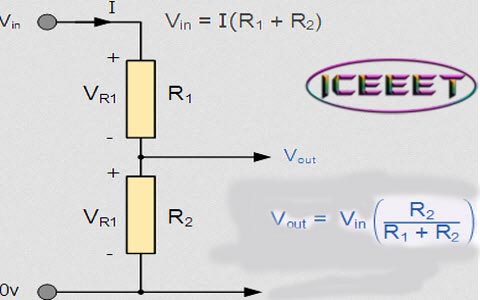Note that, The Output voltage value of a voltage divider circuit is always less than the input voltage value.
Table of Contents
Voltage Divider Rule(VDR):
Applying this rule can also solve simple circuits thoroughly, The main concept of this rule is,
“The voltage is divided between two resistors (R) which are connected in series in direct ratio to their resistance”. Voltage divider involves two important parts they are the circuit and the equation.
The voltage divider rule is simple and most important of electronics circuit, which is used to change of large voltage into a small voltage. Using just an input voltage and two series resistor we can get output voltage.

Proved Voltage divider for following this circuit:

Ohm’s law implies that voltage 1 and voltage 2 ——The ohm’s law states that V=IR.
From the above equation, we can get the two voltages—
V1 (t) =R1i (t)…………… (1)
V2 (t) =R2i (t)…………… (2)
Applying kvl from this circuit,
−v(t)+v1(t)+v2(t)=0
v(t) = v1(t)+v2(t) ………..(3)
now we can put the value of V1 (t)and V2 (t) , then we get,
v(t)=R1i(t)+R2i(t)
v(t) =(R1+R2)i(t).
hence,
i (t) =v (t) /R1+R2……………. (4)
putting the value of 4 in 1 and 2 ,
V1 (t) ={R1.V(t)/R1+R2}.
V2 (t) = {R2.V(t)/R1+R2}.
This equation shows that the voltage is divided between two series resistors in direct proportion to their resistance.
This voltage divider rule can be designed with more than two resistors.



12 comments
[…] By habib Basic Law Electrical July 20, […]
Nice bro
thanks
[…] current contacts is small as a result the voltage gradient between contacts becomes high. This high voltage gradient between the contacts ionized the oil and consequently starts arcing between the contacts. […]
[…] Circuit Breaker are used in substations for all voltages ranging from 144 to 765 kV or even above. Continuous currents up to 8000 A, and symmetrical […]
Nice…Good job..bro
thanks
[…] voltage drop in Re minimizes the voltage applied to the armature, and therefore the speed is […]
[…] a constant value of Rsh and supply voltage, V>>Ish is also constant and hence flux is also […]
how to get motivated to write my research paper
what topic should i write about for my research paper
Email please
can you write my essay
help write my essay